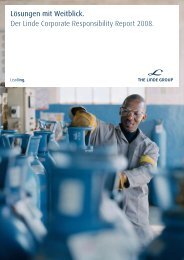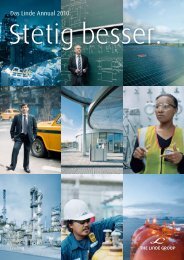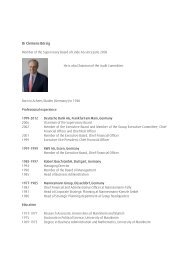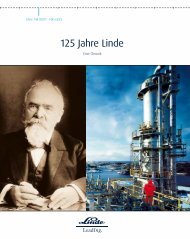The complete history of the development of The - The Linde Group
The complete history of the development of The - The Linde Group
The complete history of the development of The - The Linde Group
Create successful ePaper yourself
Turn your PDF publications into a flip-book with our unique Google optimized e-Paper software.
14<br />
N o 0023<br />
Device for <strong>the</strong> production <strong>of</strong> block ice.<br />
In 1892 <strong>the</strong> Gesellschaft für <strong>Linde</strong>’s Eismaschinen opened a large plant for<br />
chilling food and producing ice in Hamburg.<br />
When <strong>the</strong> warm winter <strong>of</strong> 1883/84 failed to yield a sufficient<br />
supply <strong>of</strong> natural ice, <strong>the</strong> last reservations as far as <strong>the</strong> reliability<br />
<strong>of</strong> artificial refrigeration were removed. And so a “veritable torrent”<br />
(<strong>Linde</strong>) <strong>of</strong> orders broke over <strong>the</strong> <strong>Linde</strong> Company and <strong>the</strong><br />
machinery builders working with it. Happily, Carl von <strong>Linde</strong> had<br />
had sufficient ice machines in standard sizes produced for stock<br />
so that <strong>the</strong> demand could be met quickly with reliable quality.<br />
By <strong>the</strong> end <strong>of</strong> <strong>the</strong> 1880s, <strong>the</strong> “Gesellschaft für <strong>Linde</strong>’s Eismaschinen”<br />
had equipped 445 breweries with 747 refrigeration<br />
machines. With year-round refrigeration ensured, <strong>the</strong> breweries<br />
could now brew bottom-fermented beer in summer as well as<br />
winter and thus considerably increase <strong>the</strong>ir pr<strong>of</strong>itability.<br />
Ice factories under own control<br />
During <strong>the</strong> first several months after <strong>the</strong> <strong>of</strong>ficial founding <strong>of</strong> <strong>the</strong><br />
company when no refrigeration machine orders were coming<br />
in, von <strong>Linde</strong> felt forced to build ice factories at his own expense.<br />
1885<br />
Pastor Friedrich von Bodelschwingh founds <strong>the</strong><br />
first building and loan association in Germany.<br />
<strong>The</strong> purpose <strong>of</strong> <strong>the</strong>se sample plants was to demonstrate <strong>the</strong>ir<br />
efficiency and cost effectiveness. His first own ice factory was<br />
built in Elberfeld-Barmen between two breweries that had<br />
agreed to take on greater quantities <strong>of</strong> <strong>the</strong> manmade ice. At <strong>the</strong><br />
same time, financier von Hirsch, who had acquired <strong>Linde</strong>’s<br />
patent rights for France, built an ice factory in Paris. And finally,<br />
parallel to this, von <strong>Linde</strong> designed a smaller ice factory for an<br />
exhibition taking place in Düsseldorf in 1880.<br />
In addition to Elberfeld-Barmen, <strong>the</strong> <strong>Linde</strong> Company had<br />
opened o<strong>the</strong>r ice factories in Stuttgart, Munich and Strasbourg<br />
by 1881. Each one produced up to 50,000 kilograms <strong>of</strong> ice per<br />
day – and at <strong>the</strong> very competitive price <strong>of</strong> 70 pfennigs per 100<br />
kilograms. Once <strong>the</strong> ice plants had proven <strong>the</strong>ir pr<strong>of</strong>itability, <strong>the</strong>y<br />
were sold by 1890 “with considerable surpluses over <strong>the</strong>ir book<br />
value” (von <strong>Linde</strong>). It was not until after 1896 that <strong>the</strong> “Gesellschaft<br />
für <strong>Linde</strong>’s Eismaschinen” – certainly due to <strong>the</strong> decline in<br />
machine sales and as capital investments – again decided to build<br />
its own ice factories and cold storage facilities in Nuremberg<br />
(1896), Leipzig (1910), Königsberg (1914) and Magdeburg (1937).<br />
Cold storage facilities market<br />
With <strong>the</strong> building <strong>of</strong> city slaughterhouses initiated by new legislation<br />
during <strong>the</strong> last third <strong>of</strong> <strong>the</strong> 19th century, <strong>the</strong> demand for<br />
cold storage houses for meat and o<strong>the</strong>r food products rose –<br />
ano<strong>the</strong>r driving force for sales <strong>of</strong> refrigeration machines. <strong>The</strong> first<br />
cold storage facility for meat was built in Bremen in 1882 with<br />
von <strong>Linde</strong> called in as an adviser.<br />
One year later von <strong>Linde</strong> supplied <strong>the</strong> equipment for <strong>the</strong> city<br />
slaughterhouse in Wiesbaden, solving <strong>the</strong> complex problem not<br />
only <strong>of</strong> generating refrigeration but at <strong>the</strong> same time dehumidifying<br />
and purifying <strong>the</strong> air.<br />
When, at <strong>the</strong> beginning <strong>of</strong> <strong>the</strong> 1890s, nearly all larger communities<br />
in Germany built <strong>the</strong>ir slaughterhouses with cold rooms<br />
and cold storage houses as a result <strong>of</strong> changed legislation, this<br />
industry quickly became <strong>the</strong> second largest market for refrigeration<br />
systems.






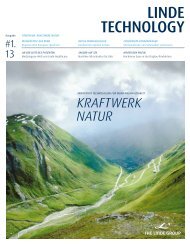

![[41] Anteilsbesitzliste des Linde Konzerns und ... - The Linde Group](https://img.yumpu.com/8356102/1/184x260/41-anteilsbesitzliste-des-linde-konzerns-und-the-linde-group.jpg?quality=85)
![[41] Anteilsbesitzliste des Linde Konzerns und ... - The Linde Group](https://img.yumpu.com/8356076/1/184x260/41-anteilsbesitzliste-des-linde-konzerns-und-the-linde-group.jpg?quality=85)
